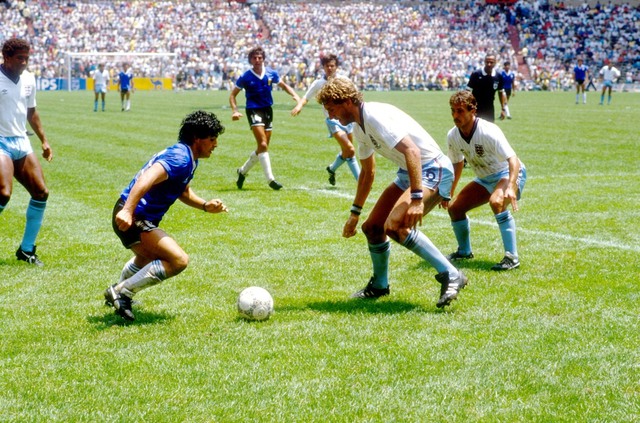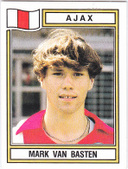
1aMarco van Basten (NED)
1983 Panini Voetbal.
One of the greatest strikers of all time, Marco Van Basten scored 277 goals in his career though injury ended his career at age 28. He won three Eredivisie titles, and was Eredivisie top scorer four seasons, with Ajax and won three Serie A titles and two Euro Cups with AC Milan. Van Basten was capped 58 times by the Netherlands and led the team to win Euro 1988, in which he scored 5 goals. He was named FIFA World Player of the Year in 1992.
| 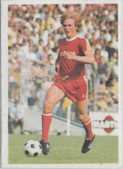
1bKarl-Heinz Rummenigge (GER)
1975 Bergmann.
Two-time European Footballer of the Year Karl-Heinz Rummenigge won the Euro Cup, two Bundesliga League titles and one Intercontinental Cup with Bayern Munich. He was a key member of the West Germany national team that won the 1980 European Championship and finished as runner-up at both the 1982 World Cup and the 1986 World Cup.
| 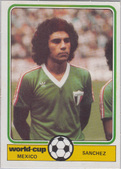
1cHugo Sánchez (MEX)
1978 Monty Gum.
The best North American player of all time (sorry Landon), Hugo Sánchez starred with Real Madrid to help them win 5 consecutive La Liga titles from 1986 to 1990. During that time, he won 4 consecutive Pichichi (he is the only player to accomplish this without sharing the trophy in any season), scoring 253 goals in 283 games. In total, he scored 382 career league goals and 29 international goals.
|
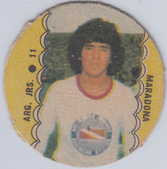
1dDiego Maradona (ARG)
1977 Fútbol.
Many experts, fans and former players consider Diego Maradona to be the greatest player of all time. In 2000, a FIFA internet poll gave Maradona 53.6% of all votes for FIFA Player of the 20th Century, with Pelé receiving 18.53%. At the last minute, FIFA made Pelé a co-recipient of the FIFA Player of the 20th Century award. With Napoli, Maradona won two Serie A titles and was runner-up twice, all within a 4-year span. This was the first time a team from Southern Italy had on a Serie A title. With Argentina, Maradona won the 1986 World Cup, was awarded the Golden ball, famously scored a handball goal against England and then single-handedly cut through the English national team defense like Lionel Messi through a bunch of toddlers. Legendary AC Milan defenders Franco Baresi and Paolo Maldini both describe Maradona as the toughest attacker they ever faced and virtually unstoppable.
| 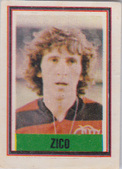
1eZico (BRA)
1976 Colecao Campeonato Nacional.
World Soccer Magazine’s Player of the Year for 1981 and 1983, Zico was perhaps the best player in the world during the late 1970s/early 1980s. He won 4 Brasileiro Série A titles with Flamengo during the 1980s. Considered one of the best layers not to win a World Cup, Brazil placed third at the 1978 World Cup and lost in the quarter-finals of the 1986 World Cup with Zico. In total, Zico scored 48 times in 71 appearances for the national team.
| 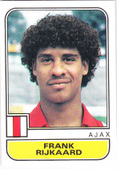
1fFrank Rijkaard (NED)
1982 Panini Voetbal.
One of the best defensive midfielders of his generation, Frank Rijkaard won 5 Eredivisie titles with Ajax and two Serie A titles with AC Milan. He finished third in Ballon d'Or voting in 1988 and 1989. Rijkaard scored the only goal in the 1990 Euro Cup final to win the cup for Milan.
|
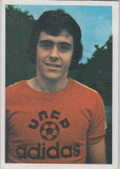
1gMichel Platini (FRA)
1974 Ageducatifs.
One of the best passers in history, Michel Platini is one of only three players to win the Ballon d'Or 3 times. With Juventus, he won two Serie A titles and was Serie A top scorer for 3 consecutive years. He led the French national team to a fourth-place finish at the 1982 World Cup and a third-place finish at the 1986 World Cup. He scored 41 goals in 72 appearances for France in total.
| 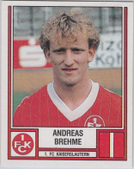
1hAndreas Brehme (GER)
1982 Panini.
One of the greatest free-kick takers and crossers of all time, left-back Andreas Brehme was one of the few players in the world who could play with both feet equally well. He won one Bundesliga title with Kaiserslautern, one with Bayern Munich and a Serie A title with Inter Milan. Brehme was named Serie A Footballer of the Year in 1989.
| 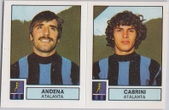
1iAntonio Cabrini (ITA)
1975 Panini.
Part of one of the most formidable defenses of all time along with Claudio Gentile, Gaetano Scirea and keeper Dino Zoff, Antonio Cabrini helped Italy finish in fourth-place at the 1978 World Cup and win the 1980 World Cup. He scored 9 career goals for Italy, a record for a defender. Playing for Juventus, Cabrini won 6 Serie A titles between 1977 and 1986.
|
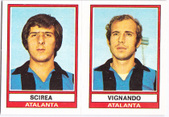
1jGaetano Scirea (ITA)
1973 Panini.
Gaetano Scirea played for the Italian national team for more than a decade during which time he was irreplaceable team’s as the leading defender, keeping Franco Baresi off the national team for four years until Scirea retired. He won 7 Serie A titles with Juventus as well as the 1985 Euro Cup. Capped 78 times in total, Scirea helped Italy place fourth at the 1978 World Cup and win the 1982 World Cup.
| 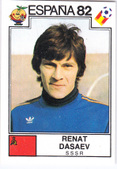
1kRinat Dasayev (RUS)
1982 Panini.
The foundation of Soviet Union team through the 1980s, Rinat Dasayev was known for his coolness under pressure and fantastic reaction saves. He helped the Soviet Union win the bronze medal at the 1980 Olympics and finish second in Euro 88. Dasayev was named Soviet Footballer of the Year in 1982 and World’s Best Goalkeeper of the Year in 1988. With 91 caps in total, he is the second-most capped player in the Soviet Union’s history.
| 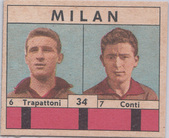
1lManager: Giovanni Trapattoni (ITA)
1961 VAV.
Considered the most successful club coach in the history of Serie A, Giovanni Trapattoni won six Serie A titles with Juventus and one with Inter Milan. As a player, he won two Serie A titles and two European Cups with AC Milan. He is one of only four managers to win league titles in 4 different countries (in Trap’s case, Italy, Germany, Portugal and Austria).
|
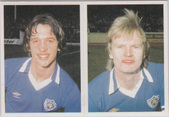
2aGary Lineker (ENG)
1981 Daily Star.
England’s record-holder for most World Cup goals with 10, striker Gary Lineker was the Premiere League’s top scorer in the 1984-85, 1985-86 and 1989-90 seasons. He won the Golden Boot at the 1986 World Cup, scoring 6 goals. In total, he scored 48 times in 80 caps for the English national team. Today, Lineker is a popular football broadcaster, hosting Match of the Day from 1999 to present.
| 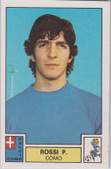
2bPaolo Rossi (ITA)
1975 Panini.
One of the greatest strikers of all time, Paolo Rossi won two Serie A titles, on European Cup and one Italian Cup with Juventus. He led Italy to victory at the 1982 World Cup, winning the Golden Ball (best player) and Golden Boot (top scorer with 6 goals, including a hat-trick that eliminated Brazil, the tournament favorite). Rossi is one of only3 players to win both awards and win the World Cup, along with Garrincha in 1962 and Mario Kempes in 1978.
| 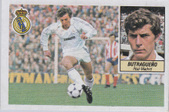
2cEmilio Butragueño (SPA)
1984 Este.
Winner of the 1991 Pichichi trophy, Emilio Butragueño won 6 La Liga titles with Real Madrid. He scored 26 international goals for the Spanish national team in 69 appearances.
|
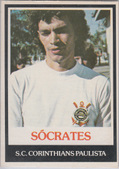
2dSócrates (BRA)
1978 Ping Pong.
Sócrates was a two-footed playmaker and scorer who played most of his career in his native Brazil. He was named South American Footballer of the Year in 1983. He scored 292 league goals in total in 640 matches. For Brazil, he scored 22 goals in 60 appearances and captained the national team at the 1982 World Cup.
| 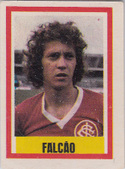
2ePaulo Roberto Falcão (BRA)
1976 Colecao Campeonato Nacional.
Central midfielder Falcão won 3 Brasileiro Série A titles with Sport Club Internacional and one Serie A title and two Italian Cups with Roma. Falcão was capped 28 times by Brazil.
| 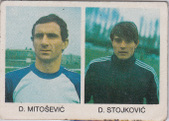
2fDragan Stojković (YUG)
1982 Football Clubs and Players.
“Piksi” Dragan Stojković is considered one of the most talent players in the history of Yugoslavian and Serbian football but his club career was largely effected by injury. He is one of the five players to be awarded the title Star of the Red Star. Stojković was named to the 1990 World Cup All-Star Team after leading Yugoslavia to the quarter-finals where they lost on penalty kicks to eventual tournament champion Argentina. He captained Yugoslavia at the 1998 World Cup where the team made it to the Round of 16.
|
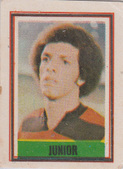
2gJúnior (BRA)
1976 Colecao Campeonato Nacional.
Left back/midfielder Júnior led Flamengo to 4 Brazilian championships. He also played in Italy where he was named Serie A Player of the Year in 1985. Júnior was capped 70 times by the Brazilian national side, including starting for the 1982 and 1986 World Cup teams.
| 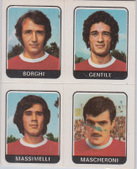
2hClaudio Gentile (ITA)
1972 Panini.
A tenacious defender known for his tight, heavy marking as well as his hard challenges, Claudio Gentile won six Serie A titles and two Italian Cups with Juventus. He was a key member of the Italian national team that finished fourth at the 1978 World Cup and won the 1982 World Cup. In the latter tournament, Gentile gained notoriety for his aggressive man-marking of Diego Maradona in a second-round match holding him scoreless and famously declaring after the match that "Football is not for ballerinas!”
| 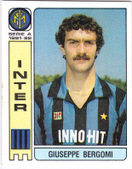
2iGiuseppe Bergomi (ITA)
1981 Panini.
Giuseppe Bergomi spent his entire career at Inter Milan with whom he won one Serie A title and three Italian Cups, and served as the side’s long-term captain. Capped 81 times for Italy, Bergomi was a member of the 1982 national team that won the World Cup and of the team that finished in third place at the 1990 World Cup.
|
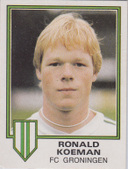
2jRonald Koeman (NED)
1981 Panini.
The all-time top scoring defender in world football, Ronald Koeman scored 193 career league goals. As a player, he won 4 Eredivisie titles with PSV Eindhoven and Ajax and 4 consecutive La Liga titles with Barcelona as part of Johan Cruyff’s “Dream Team.” Capped 78 times by the Dutch national team, Koeman helped the Netherlands win Euro 88. Koeman has also led a successful career as a manager, including winning the Rinus Michels Award in the 2011-12 season.
| 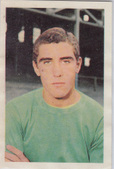
2kPeter Shilton (ENG)
1967 FKS.
England’s most-capped player with 125 appearances, Peter Shilton is the co-record holder for most World Cup clean sheets, with 10. With Shilton, England finished in fourth place at the 1990 World Cup. Playing for Nottingham Forrest, he won one Premiere League title and two Euro Cups.
| 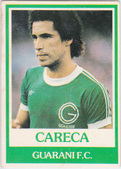
3aCareca (BRA)
1978 Ping Pong.
Careca was the best Brazilian Striker during the 1980s. He is most famous for the 1986 World Cup in which Brazil lost to France in the quarter-finals on penalty kicks. Careca was awarded the Silver Boot with 5 goals in the tournament. Careca won Brasileiro Série A titles with Guarani and São Paulo. He then moved to Italy where he was part of the “Ma-Gi-Ca” forward lineup with Diego Maradona and Bruno Giordano and helped the club win the 1990 Serie A title.
|
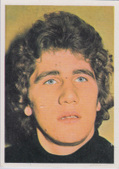
3bJean-Marie Pfaff (BEL)
1972 Panini.
Belgium goalkeeper Jean-Marie Pfaff won three Bundesliga consecutive titles from 1985 to 1987 with Bayern Munich and two German cups in 1984 and 1986. He was capped 64 times by the Belgium and started for the national team at both the 1982 and 1986 World Cups.
| 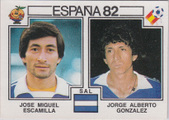
3cMágico González (SAL)
1982 Panini.
Central America’s all-time best player Jorge Alberto González, better known as “Mágico”, was a midfielder and forward with superb ball control. He represented El Salvador for more than two decades, capped 62 times in total. Many critics say that if González had been Argentinian or Brazilian, he would have been ranked alongside the best ever South American players.
| 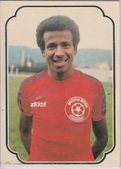
3dJean Tigana (FRA)
1979 Americana France.
One of the best midfielders in the world during the1980s, Jean Tigana won Lique 1 three times with Bordeaux and twice with Olympique de Marseille. He was capped 52 times by France and was a member of the French national team that won the European Championship in 1984. Tigana was runner-up for the Ballon d'Or in 1984.
|
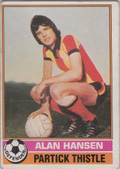
3eAlan Hansen (SCO)
1977 Topps.
Before he was a famous television football pundit, Alan Hansen was central defender for the great 1970s/80s Liverpool team that won 8 Premiere League titles between 1978 and 1989, as well as 3 FA Cups and 4 League Cups. He received 26 caps for Scotland. Hansen appeared on England’s main football program, Match of the Day, between 1992 and 2014.
| 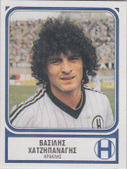
3fVasilis Hatzipanagis (GRE)
1984 Panini.
Greece’s greatest-ever footballer, attacking midfielder Vasilis Hatzipanagis is sometimes referred to as the “Greek Maradona.” Hatzipanagis was born in Russia and is said to have been the Soviet Union’s second-best left-side attacker in 1974 after Oleg Blochin. After the military dictatorship in Greece ended in 1974, he moved back to Greece where he played for Iraklis Thessaloniki FC for 16 years in what was the most prominent period in modern Greek football. Contributing to his relative obscurity is the fact that FIFA ruled Hatzipanagis ineligible to play for the Greece national team due to his previous tenure with the Soviet Union, however, from a pure talent point of view, Hatzipanagis is considered one of the best attacking midfielders the world has seen. His talent was recognized in 1984 when he was named to an all-world XI team alongside Franz Beckenbauer, Mario Kempes and Kevin Keegan.
| 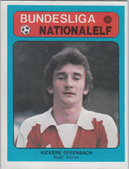
3gRudi Völler (GER)
1978 Americana München.
German striker Rudi Völler has the distinction, along with Franz Beckenbauer, of reaching the World Cup finals as both a player and a manager. He was the Bundesliga’s top goalscorer in 1981 and 1982 and scored 257 goals in his club career, playing in Germany, Italy and France. Völler was caped 90 times by the German national team, scoring 47 goals. He was a member of the German team that won the 1990 World Cup and finished second in the 1986 tournament. H managed the national team at the 2002 World Cup where the team lost to Brazil in the final match.
|
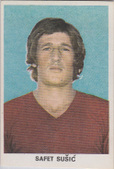
3hSafet Sušić
1974 Players and Clubs Edition.
Considered perhaps the best Bosnian player ever, Safet Sušić was one of the best midfielders of the late 1970s/early 1980s. He was the top goal scorer in Yugoslav First League in the 1979-80 season and led PSG to a French Cup in the 1982-83 season and to a league title in the 1985-86 season. Sušić started for Yugoslavia in both the 1982 and 1990 World Cups and scored 21 career goals in 54 appearances for the national side. Sušić is also a highly successful manager, taking the Bosnia and Herzegovina national team to the 2014 World Cup.
| 
3iMario Tardelli (ITA)
1974 Panini.
Hard-tackling defensive midfielder Marco Tardelli won five Serie A titles and one European Cup with Juventus. Playing for Italy, he was a key member of the team that won the 1982 World Cup, scoring against Argentina and in the final match versus West Germany. His celebratory run after scoring the latter goal – running towards his team’s bench with fists clenched and shouting “Go! Go!” has become known as the “Tardelli cry.” In all, he was capped 81 times in total by the Italian national team.
| 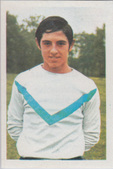
3jAlain Giresse (FRA)
1970 Etoiles du Football.
French Footballer of the Year for 1982, 1983 and 1987, midfielder Alain Giresse won two Ligue 1 titles and two Coupes de France with Bordeaux. Capped 47 times by France, he was a member of 1982 and 1986 World Cup sides that finished fourth and third in their respective tournaments as well as the French side that won the 1984 European Championship.
|
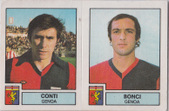
3kBruno Conti (ITA)
1975 Panini.
One of Italy’s all-time wingers, Bruno Conti was a key player the Italian national side that won the 1982 World Cup. During the tournament, he was given the nickname "Mara-Zico", a reference to both Maradona and Zico. With Roma, he won five Coppia Italia titles.
| 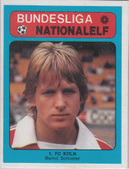
3lBernd Schuster (GER)
1978 Americana München.
German midfielder Bernd Schuster was a key player on dominant Barcelona and Real Madrid teams of the early 1980s which his teams won three La Liga titles and four Copas del Rey. Schuster was part of the West German national side that won the 1980 European Championship.
| 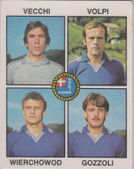
3mPietro Vierchowod
1979 Panini.
An Italian centre-back of Ukranian decent, Pietro Vierchowod was a key member of the Italian national team that won the 1982 World Cup. Nicknamed, “the Tsar”, he was also a member of the Juventus side that won the 1995-96 Champions League.
|
